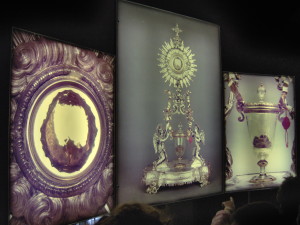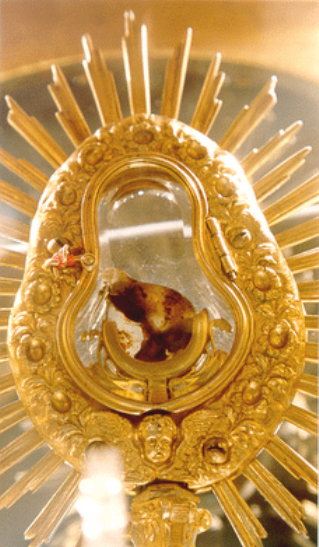Eucharistic Miracles – Facts, Research, Videos
“This is my Body which will be given up for you…”
Throughout Christian history, our Lord has shown us that he is really present as the Blessed Sacrament. Most Eucharistic miracles involve incidences in which the Host has “turned into human flesh and blood”. Of course we as Catholics believe that the consecrated Host is the Body, Blood, Soul, and Divinity of our Lord, under the appearances of bread and wine. Therefore, Jesus, through these miracles, merely manifests His Presence in a more tangible way.
Then he said to Thomas, ‘Put your finger here, and see my hands; and put out your hand, and place it in my side; do not be faithless, but believing.’ Thomas answered him, ‘My Lord and my God!’ Jesus said to him, ‘Have you believed because you have seen me? Blessed are those who have not seen and yet believe.‘” (Jn 20:27-29)
“Take this, all of you, and eat it: This is my body, which will be given up for you.” Then he lifts the cup and says, “Take this, all of you, and drink from it: This is the cup of my blood, the blood of the new and everlasting covenant. It will be shed for you and for all so that sins may be forgiven. Do this in memory of me.”
The doctrine of transubstantiation, which is the teaching that bread and wine are converted into the actual flesh and blood of Jesus Christ, is difficult for many to understand. When Christ first told his followers of it, many rejected him believing it was an outrageous claim. But Jesus did not back down, he did not try and clarify his statement or correct their misunderstanding. He simply repeated his command to the disciples at the Last Supper. “This is My Body…. This is My Blood. Some Christians today still have trouble accepting this teaching and don’t quite understand it. The bread and wine turn into the Body and Blood of Christ. A physical sign of the new covenant between God and Man, reminded through the sacrifice of Christ, that redemption can be had.
Throughout history, though, many people have reported miracles that brought them back to the truth. The Church has recognized over one hundred Eucharistic miracles, many of which occurred during times of weakened faith in transubstantiation.
Some Modern Eucharistic Miracles
Excerpted with permission from Daniel Sanford
The Bleeding Host Miracle occurred in Betania, Venezuela on December 8th, 1991 (The Feast of the Immaculate Conception) during the celebration of the Holy Mass at midnight. The celebrant, Father Otty Ossa Aristiza`bal, the Betania Chaplain, had just finished the Consecration, had broken the large Host into four pieces, and took one piece of the Host for his consumption and placed the remaining portions on the plate on the altar. When he looked down at the remaining Host, to his amazement he saw a red substance coming out of it which he described as if it was spurting from a wound. He placed the Host in a Chalice and put it in the Tabernacle until 6 a.m. the next morning. When he looked at it again it was still bleeding, so he placed it in a Monstrance and took it to show the people at Mass. Eyewitnesses saw the Host bleeding and blood accumulating on the bottom of the Monstrance. Some filmed it on their camcorders. Bishop Ricardo of Los Teques was advised, and he had the Host tested in Caracas. He was told that the red substance was IN FACT human blood. Subsequently, the Miraculous Host was taken to the convent of the Augustinian Nuns in Los Teques for safekeeping, adoration, and visitation by pilgrims.
Daniel Sanford of New Jersey journeyed to Betania, Venezuela from 11/12/98 til 11/15/98 on a pilgrimage with an organized Prayer Group from Medford Lakes, NJ. On 11/13/98, as part of the pilgrimage, they went to see the Bleeding Host of Betania at the Chapel of the Augustinian Nuns in Los Teques. Our Spiritual Director, Father Mazzarella, said Daily Mass. When we finished, he opened the Tabernacle door, which contained the Bleeding Host. The Host was in flames, bleeding, and there was a pulsating heart bleeding in the center of the Host. The Group watched this for about 30 seconds or so, then the Host returned to normal. HOWEVER, Daniel did manage to film this miracle with his camcorder!There were 10-15 other people standing next to me also taking still pictures, but, they saw nothing, and nothing was recorded on their pictures except the normal condition of the Host, seen everyday.I rewound the film right away and played it back to all present, including the Nuns, the Tour Guide, and the Bus Driver, and the tape revealed the Host just as I saw it: burning, bleeding, and a pulsating heart in the middle!The tape was sent to the Bishop of Los Teques, Pio Bello S.J. Bishop Emeritus of Los Teques asking his advice as to what to do with the Video Vision I was given. You can view his Letter of Response on the left in the Directory.
When I spoke to him, I informed him that I would be in strict obedience to his advice and hoped what I witnessed was not just my mind playing tricks on me. His response was that “you can fool the mind, but the camera only films what it sees!”. He advised me to evangelize the True Presence, and this has been my ministry since 11/13/98 and WILL be until my last breath.
If you would like a copy of this Miraculous Videotape, simply send me your name and address at:
The Bleeding Host Miracle
329 Cypress Ave
Woodlynne, NJ 08107
Results of all the scientific experimentation and testing of the Eucharistic Miracles below…
The analyses were conducted with absolute and unquestionable scientific precision and they were documented with a series of microscopic photographs. These analyses sustained the following conclusions:
- The Flesh is real Flesh. The Blood is real Blood.
- The Flesh and the Blood belong to the human species.
- The Flesh consists of the muscular tissue of the heart.
- In the Flesh we see present in section: the myocardium, the endocardium, the vagus nerve and also the left ventricle of the heart for the large thickness of the myocardium.
- The Flesh is a “HEART” complete in its essential structure.
- The Flesh and the Blood have the same blood-type: AB (Blood-type identical to that which Prof. Baima Bollone uncovered in the Holy Shroud of Turin).
- In the Blood there were found proteins in the same normal proportions (percentage-wise) as are found in the sero-proteic make-up of the fresh normal blood.
- In the Blood there were also found these minerals: chlorides, phosphorus, magnesium, potassium, sodium and calcium.
- The preservation of the Flesh and of the Blood, which were left in their natural state for twelve centuries and exposed to the action of atmospheric and biological agents, remains an extraordinary phenomenon.
[su_youtube url=”https://youtu.be/oogJ-cdi7yI” width=”400″ height=”380″][/su_youtube]
Argentina Miracle of the Host (Pope Francis as a Cardinal ordered Scientific Forensics on the Host) –
Back in 1996, when Pope Francis was formerly Cardinal Jorge Bergoglio, a miracle of the Host occurred in Buenos Aires. On August 18, 1996, three days after the feast of the Assumption of Our Lady, a woman came up to Fr. Alejandro Pezet after Holy Mass in a local church, and pointed to a discarded Host on a candleholder at the back of the church. Unable to consume the Host, Fr. Pezet put it in a container with water and placed it inside the tabernacle.
Argentina-miracle-of-the HostOn August 26, a week later, as he opened the tabernacle, he saw that the Host had turned blood red. He informed Bergoglio, who immediately had it photographed. On September 6, the photographs revealed that the Host “had become a fragment of bloodied flesh and had grown significantly in size”. For years, the Host was kept secretly in the tabernacle. On October 5, 1999, Bergoglio, now an Archbishop, seeing that the Host did not decompose, sent it for scientific analysis in New York City through his representative Dr. Castanon.
Dr. Castanon purposely did not give any background about the Host to Dr. Frederic Zugiba, a well-known cardiologist and forensic pathologist, who did the examination. His findings revealed the it was “real flesh and blood and containing human DNA. Zugiba testified that the material was a fragment of the heart muscle responsible for contraction to supply blood to all parts of the body.
Dr. Zugiba reported that the examined material was inflamed flesh containing a lot of white blood cells, indicating that the heart was alive at the time the sample was taken. Dr. Zugiba added that white blood cells would die in a matter of minutes if the heart was no longer alive and functioning. The white blood cells had penetrated the tissue, indicating that the heart had been under severe stress, as if the owner had a trauma of being beaten on the chest. This reminds us of the pain and trauma of the Crucifixion of our Lord.
Finally informed that it was a Host, Dr. Zugiba was shocked and said, “How and why a consecrated Host would change its character and become living human flesh and blood will remain an inexplicable mystery to science.”
This Section is borrowed from the RealPresence.Org Web Site. We Thank them for their mission and the use of this material.
 | Sienna, Italy — August 17, 1730 Consecrated Hosts remain perfectly preserved for over 250 years. Rigorous scientific experiments have not been able to explain this phenomena. |
| Amsterdam, Holland 1345 Eucharist thrown into fire overnight miraculously is unscathed. | |
 | Blanot, France — March 31, 1331 The Eucharist falls out of a woman’s mouth onto an altar rail cloth. The priest tries to recover the Host but all that remains is a large spot of blood the same size and dimensions as the wafer. |
| Bolsena-Orvieta, Italy Again, a priest has difficulties believing in the Real Presence, and blood begins seeping out of the Host upon consecration. Because of this miracle, Pope Urban IV commissioned the feast of Corpus Christi, which is still celebrated today. | |
 | Lanciano, Italy — 8th century A.D. A priest has doubts about the Real Presence; however, when he consecrates the Host it transforms into flesh and blood. This miracle has undergone extensive scientific examination and can only be explained as a miracle. The flesh is actually cardiac tissue which contains arterioles, veins, and nerve fibers. The blood type as in all other approved Eucharistic miracles is type AB! Histological micrographs are shown. |
| Physician Tells of Eucharistic Miracle of Lanciano (Zenit) “Dr. Edoardo Linoli says he held real cardiac tissue in his hands, when some years ago he analyzed the relics of the Eucharistic miracle of Lanciano, Italy.” |
Listing of Vatican Approved Eucharistic Miracles by Country as of 2018
There are currently 153 Vatican Approved Eucharistic Miracles on file.
Argentina
Buenos Aires, 1992 – 1994 – 1996 (part 1)
Buenos Aires, 1992 – 1994 – 1996 (part 2)
Buenos Aires, 1992 – 1994 – 1996 (part 3)
Austria
Fiecht, 1310
Seefeld, 1384
Weiten-Raxendorf, 1411
Belgium
Bois-Seigneur-Isaac, 1405
Bruges, 1203
Brussels, 1370
Herentals, 1412
Herkenrode-Hasselt, 1317
Liège (Corpus Christi), 1374
Middleburg-Lovanio, 1374
Carribean Island of Martinique
Morne-Rouge, 1902
Colombia
Tumaco, 1906
Croatia
Ludbreg, 1411 (part 1)
Ludbreg, 1411 (part 2)
Egypt
Jordan / Arabian Desert – St. Mary of Egypt, 6th Century
Scete, 3rd -5th Century
France
Avignon, 1433 (part 1)
Avignon, 1433 (part 2)
Blanot, 1331
Bordeaux, 1822
Dijon, 1430
Douai, 1254
Faverney, 1608
La Rochelle, 1461 Neuvy Saint Sépulcre, 1257
Les Ulmes, 1668
Marseille-En-Beauvais, 1533
Paris, 1290 (part 1)
Paris, 1290 (part 2)
Pressac, 1643
Germany
Augsburg, 1194
Benningen, 1216
Bettbrunn, 1125
Erding, 1417
Kranenburg, District of Kleve, 1280
Regensburg, 1255
Walldürn, 1330
Weingarten (part 1)
Weingarten (part 2)
Wilsnack, 1383
India
Chirattakonam, 2001
Island of La Réunion
Saint-André de la Réunion, 1902
Italy
Alatri, 1228
Assisi (Saint Clare), 1240
Asti, 1535
Asti, 1718
Bagno Di Romagna, 1412
Bolsena, 1264 (part 1)
Bolsena, 1264 (part 2)
Canosio, 1630
Cascia, 1330
Cava Dei Tirreni, 1656
Dronero, 1631 San Mauro La Bruca, 1969
Ferrara, 1171
Florence, 1230-1594
Gruaro aka Gruaro (Valvasone), 1294
Lanciano1 aka Lanciano, 750 A.D. (part 1)
Lanciano2 aka Lanciano, 750 A.D. (part 2)
Macerata aka Macerata, 1356
Mogoro aka Mogoro, 1604
Morrovalle aka Morrovalle, 1560
Offida aka Offida, 1273-1280
Patierno aka Patierno (Naples), 1772
Rimini aka Rimini, 1227
Rome1 aka Rome, 6th -7th Centuries (part 1)
Rome2 aka Rome, 6th -7th Centuries (part 2)
Rome3 aka Rome, 1610
Rosano aka Rosano, 1948
Damian-Scala aka Saint Peter Damian, 11th Century Scala, 1732
Salzano aka Salzano, 1517
Siena aka Siena, 1730
Trani aka Trani, 11th Century
Turin1 aka Turin, 1453 (part 1)
Turin2 aka Turin, 1453 (part 2)
Turin3 aka Turin, 1640
Veroli aka Veroli, 1570
Volterra aka Volterra, 1472
Mexico
Tixtla1 aka Tixtla, October 21, 2006 (part 1)
Tixtla2 aka Tixtla, October 21, 2006 (part 2)
Netherlands
Alkmaar, 1429
Amsterdam, 1345 (part 1)
Amsterdam, 1345 (part 2)
Bergen, 1421
Boxmeer, 1400
Boxtel-Hoogstraten, 1380
Breda-Niervaart, 1300
Meerssen, 1222-1465
Stiphout, 1342
Peru
Eten, 1649
Poland
Glotowo, 1290(PDF: 147k)
Krakow, 1345(PDF: 170k)
Poznan, 1399(PDF: 158k)
Sokólka, October 12, 2008 (Part 1)
Sokólka, October 12, 2008 (Part 2)
Sokólka, October 12, 2008 (Part 3)
Portugal
Santarém, 1247 (part 1)
Santarém, 1247 (part 2)
Spain
Alboraya-Almácera, 1348 (part 1)
Alboraya-Almácera, 1348 (part 2)
Alcalá, 1597
Alcoy, 1568
Caravaca de la Cruz, 1231
Cimballa, 1370
Daroca, 1239 (part 1)
Daroca, 1239 (part 2)
Gerona, 1297
Gorkum-El Escorial, 1572
Guadalupe aka Guadalupe, 1420
Ivorra1 aka Ivorra, 1010 (part 1)
Ivorra2 aka Ivorra, 1010 (part 2)
Moncada aka Moncada, 1392
Montserrat aka Montserrat, 1657
Ocebreiro aka O’Cebreiro, 1300
Onil1 aka Onil, 1824 (part 1)
Onil2 aka Onil, 1824 (part 2)
Ponferrada aka Ponferrada, 1533
johnofabbesses aka Saint John of the Abbesses, 1251
Silla aka Silla, 1907
Valencia1 aka Valencia (part 1)
Valencia2 aka Valencia (part 2)
Zaragoza aka Zaragoza, 1427
Switzerland
Ettiswil, 1447
Venezuela
Betania aka Betania, December 8, 1991
Additional Photographs of Eucharistic Miracles
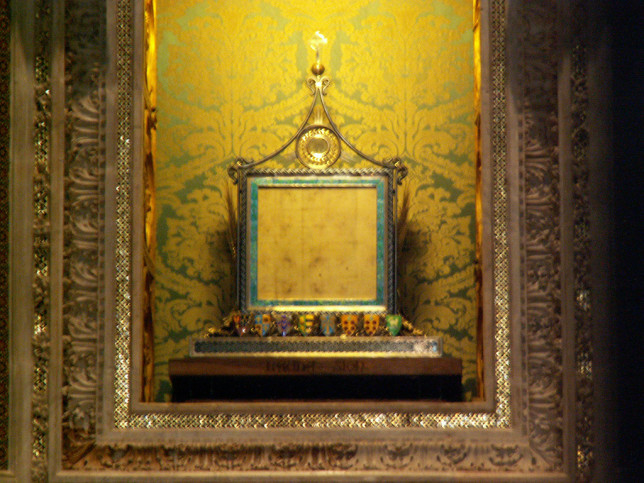
Corporal of Bolsena
The Corporal of Bolsena dates from a Eucharistic miracle in Bolsena, Italy, in 1263 when a consecrated host allegedly began to bleed onto a corporal, the small cloth upon which the host and chalice rest during the Canon of the Mass. The appearance of blood was seen as a miracle to affirm the Roman Catholic doctrine of transubstantiation, which states that the bread and wine become the Body and Blood of Christ at the moment of consecration during the Mass. Today the Corporal of Bolsena is preserved in a rich reliquary at Orvieto in the cathedral. The reddish spots on the cloth, upon close observation, show the profile of a face similar to those that traditionally represent Jesus Christ.
The Eucharistic miracle of Santarém, together with that of Lanciano, is considered among the most important Eucharistic miracles. Numerous studies and canonical analyses were carried out on the relics. The Host changed into bleeding Flesh and Blood flowed out of the Blessed Sacrament. Both relics are preserved to this day in the Church of St. Stephen in Santarém.
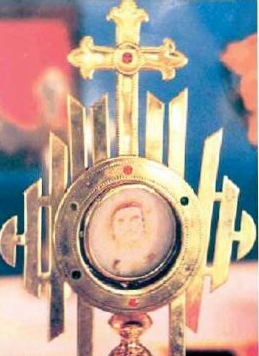
Miracle of Chirattakonam India
This Eucharistic miracle was verified recently, on May 5, 2001 in Trivandrum, India. In the Host there appeared the likeness of a man similar to that of Christ crowned with thorns. His Beatitude Cyril Mar Baselice, Archbishop of the diocese of Trivandrum, wrote regarding this prodigy: “[…] For us believers what we have seen is something that we have always believed […]. If our Lord is speaking to us by giving us this sign, it certainly needs a response from us”. The monstrance containing the miraculous Host is to this day kept in the church.
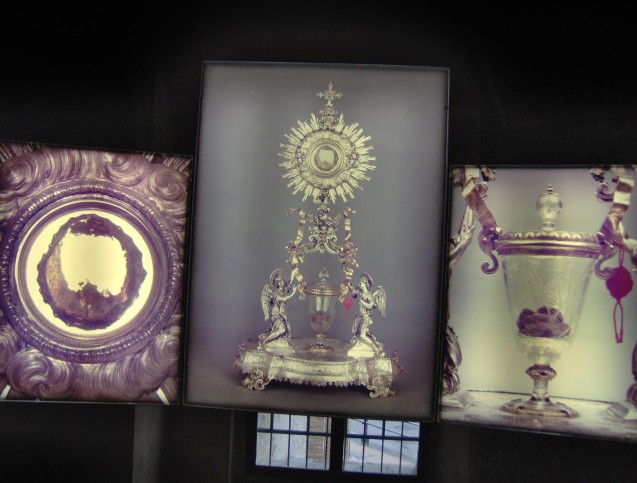
Miracle of Lanciano
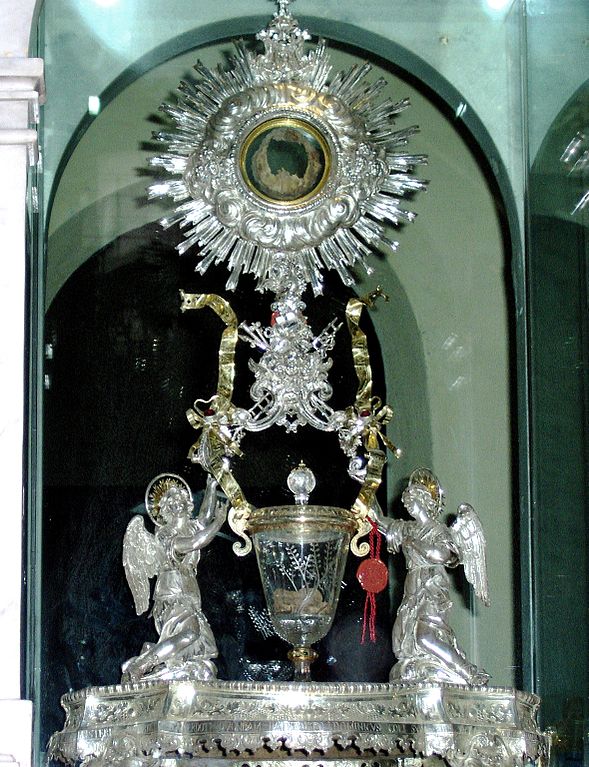
Miracle of Lanciano Italy
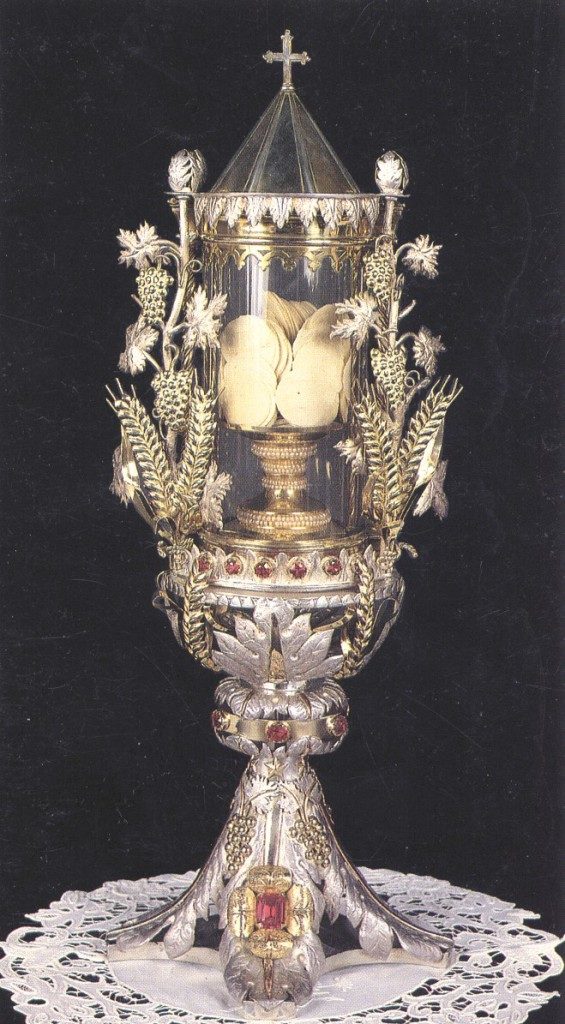
The Hosts of Siena Italy
